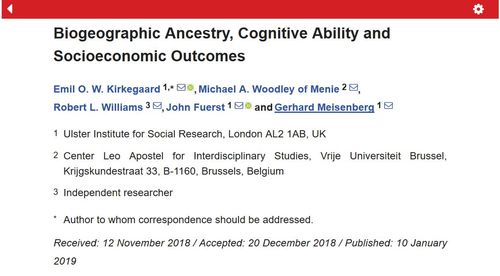
"Biogeographic Ancestry, Cognitive Ability and Socioeconomic Outcomes"
By Steve Sailer
01/30/2019

From Psych:
Biogeographic Ancestry, Cognitive Ability and Socioeconomic Outcomes
Emil O. W. Kirkegaard,* OrcID, Michael A. Woodley of Menie, Robert L. Williams, John Fuerst and Gerhard Meisenberg
They found a database of 1,369 American kids, average age 11 or 12, for which they have both genes, allowing them to look racial ancestry (horizontal axis) and scores on an IQ-like test of cognitive ability (vertical axis).
Among those who self-identified as black (blue dots) and white (red dots), there wasn’t much overlap. There’s one red dot way off in the nonwhite section and about a dozen people near 50/50 white/nonwhite. But even though the Economist says there is no doubt vast confusion over self-identification, there actually isn’t much. Two individuals are self-identified as white who are less than 50% white by genetic ancestry estimate (one substantially, one marginally). And two individuals are self-identified as black who are more than 50% white, but none more than about 5/8ths white.
In general, even among the new generation, there aren’t all that many people who are mostly white but partly black.
A couple of things to keep in mind is that these are children and the self-identification is probably done by their parents. Parents in mixed marriages are more likely, I imagine, to pick “Multi-Ethnic” for their children. In contrast, children can have strong opinions. For example, in 2010 President Barack Obama told the Census that he wasn’t white, just black.
